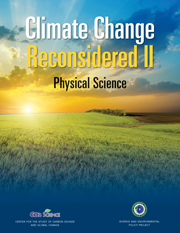New material posted nearly every day!
Last 15 Postings
CO2 and Temperature Effects on Maize Yield and Protein Content (9 September 2016)
When atmospheric CO2 and temperature rise together, some good things happen to maize plants and the many people throughout the world that depend upon them for a goodly portion of the food that they and their farm animals eat...
Modeling North American Extreme Temperature Events and Patterns (8 September 2016)
After all the time and money that has gone into the enterprise, almost everyone is still asking the age-old question: Are we there yet???...
CO2-Enrichment Boosts the Growth and Water Use Efficiency of Two Tomato Cultivars (7 September 2016)
Both a drought-tolerant and a heat-tolerant tomato cultivar respond in a positive manner to atmospheric CO2 concentrations expected by the end of this century...
How Are Earth's Islands Being Impacted by Rising Sea Levels? (6 September 2016)
Climate alarmists are shedding elephant tears over what their models predict for the future: gradually increasing island inundation. But Earth's islands are not being swamped by the slow-rising water; they are actually growing ever larger...
How Local Adaptation Can Help Plants Cope with Climate Change (6 September 2016)
Living on the edge of water scarcity, various plants are able to survive by developing the ability to adapt to the situation...
Plant Growth Database (6 September 2016)
Our latest posting of plant growth responses to atmospheric CO2 enrichment obtained from experiments described in the peer-reviewed scientific literature is for well-watered and fertilized barley plants (Schmid et al., 2016). To access the entire database, click here.
Tree Range Shifts (2 September 2016)
Out in the real world of nature, there are situations where either one or the other or a combination of the two causes of altitudinal tree migration have been responsible for the observed phenomenon...
1200 Years of Historic Streamflow in the Eastern Great Basin of North America (1 September 2016)
What does it reveal about the natural variability of climate in this region?...
Modeling 12 Centuries of Northern Hemispheric Hydroclimate (31 August 2016)
Once again, the current slate of climate models is shown to be unable to correctly hind-cast the behavior of an important climatic phenomenon...
How Genomics Can Help Feed Earth's Growing Human Population (30 August 2016)
Just as there is more than one way to skin a cat, there are also more ways of ensuring that the increasing population of our planetary home will have enough food to eat throughout the eons to come...
Two Decades of Changing Bird Abundances on Mt. Kilimanjaro (29 August 2016)
Contrary to alarmist expectations, rising temperatures and ongoing habitat disturbances have not negatively impacted bird abundances on Mt. Kilimanjaro. In fact, by most measures they appear to have led to enhanced abundances...
Elevated CO2 Stimulates the Growth of an Aquatic Fern (29 August 2016)
A four-fold increase in atmospheric CO2 leads to a two-fold stimulation of Azolla filiculoides...
Plant Growth Database (26 August 2016)
Our latest result of plant growth responses to atmospheric CO2 enrichment obtained from experiments described in the peer-reviewed scientific literature is for Old Man Saltbush. To access the entire database, click here.
The Interactive Effects of CO2 and Temperature on Wheat and Rice (25 August 2016)
A four-year FACE study reveals a stimulatory effect of atmospheric CO2 enrichment on these two crops under both ambient and elevated temperature conditions...
The Behavioral Plasticity of the American Pika (24 August 2016)
Behavioral adjustments are one important mechanism by which the American pika can persist outside of its previously appreciated dietary and thermal niches. And that is good news, for those who might be concerned about the potential impacts of global warming on this mammal species...
Videos
| Seeing is Believing |
Atmospheric Carbon Dioxide and Interglacial Warmth |
Click here to watch additional videos on various global warming topics, to embed any of our videos on your own web page, or to watch them on YouTube in a higher resolution.





